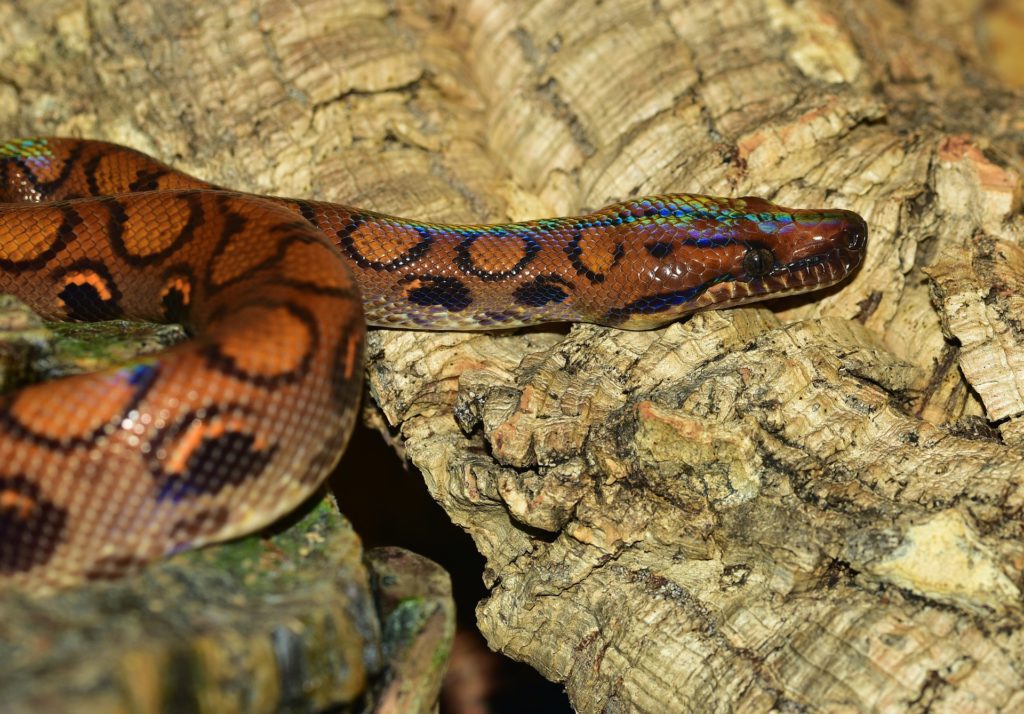The Brazilian rainbow boas are incredibly beautiful. These snakes make good companions and are relatively easy to care for. They are native to central South America and Costa Rica, where their natural habitat is the grounds of swamps, grasslands and on trees.
Before adopting this snake, it would be best to determine whether it will be a good pet for you to keep. Therefore, we'll delve deep into whether the Brazilian rainbow boas make good pets.
Are Brazilian Rainbow Boas Good for Beginners?
A Brazilian rainbow boa, sometimes known as the rainbow boa constrictor, can make a good pet for beginners. However, this pet can only be good for beginners if they follow the suitable care process that is unique to this boa. Some breeders establish that the Brazilian rainbow boa is more suitable for intermediate snake keepers.
This snake can grow as long as seven feet in length. Thus, the Brazilian rainbow boa size makes it manageable for most people.
Are Brazilian Rainbow Boas Good Pets?
The rainbow boas are one of the most popular snake species by snake lovers. These snakes make good pets in captivity as they are easy to care for. Providing the right care is the trick to raising healthy and happy Brazilian rainbow boas.

Pixabay on Pexels
How To Care for the Brazilian Rainbow Boas
As stated above, the Brazilian rainbow tree boa is easy to care for. These snakes need the right amount of humidity, temperature and light for optimal survival. Thus, if you intend to keep this snake, you must be well-versed in the Brazilian rainbow boa care process. Here is a simple guide on everything you need to provide good boas care.
Habitat requirements
A Brazilian rainbow boa enclosure must be spacious enough for your snake to exercise and stretch until it reaches maximum length. Experts recommend a terrarium that is about 6 by x 2 x 2 feet long. The best enclosure you can offer should be plastic or glass.
Some of the best enclosures in the market include the REPTI ZOO Front Double Hinge Door with PVC Background Reptile Glass Terrarium Tank and the NEPTONION 48 Gallon Professional Glass Terrarium. The terrarium you provide your snake should offer ventilation and have a securely-fitted lid to prevent escape. Note that a happy pet is a good companion.
Lighting and heating
A rainbow boa requires a low-level UVB light to be healthy. This light can also help to increase your pet's activity levels. Note that the boas do not bask, so you should not keep the light on for long; 8–12 hours is sufficient for your snake.
When it comes to heating, rainbow boas require high temperatures for optimal health. Make sure to have heating pads or ceramic heat bulbs and maintain temperatures of about 86° F on the warmer side and 72° F on the cooler side of the tank. Have thermometers on either side of the terrarium to keep track of the temperature levels.
Humidity
The enclosure should have an untippable water bowl. This bowl should be large enough for your snake to soak in. The bowl will also hydrate your rainbow boa, sustain suitable humidity levels and aid in snake shedding.
Ensure the humidity within the terrarium is about 70% to 80%. Use a humidity gauge to track the humidity levels. During shedding, ensure that humidity is higher. One way to increase humidity in your snake's enclosure is by providing a humid hideaway comprising moist, sphagnum moss. Note that if you opt to use the moss, make sure to change it frequently to bar mold growth.
Substrate
The best substrate for the enclosure is paper-based bedding, which is easily digestible if ingested. Also, aspen shavings, like the Zoo Med Aspen Snake Bedding, are ideal. However, it would help if you avoided cedar and pine chips as they can affect your pet's respiratory system and irritate the skin,
Note that your substrate should be deep enough for your snake to burrow. In addition, you should change the substrate monthly. If you opt for weekly substrate change, you may cause your boa to have stress as these snakes prefer a solitary life. Also, avoid using reptile carpet as it is abrasive and may prevent your snake from burrowing and digging, ensuring you have an unhappy pet.
Feeding
One of the best things about the Brazilian rainbow boa is that they are not fussy eaters. Feeding a baby rainbow boa should be every 5 to 10 days. You can offer them small mice and gradually provide larger prey as they grow.
A full-grown rainbow boa will eat once every week and can take one or two rats per feeding. When feeding your snake, avoid live rodents, as they may bite your pet if the snake is not hungry. Any bite may lead to life-threatening injuries.
Do Rainbow Boas Like To Be Handled?
A juvenile Brazilian rainbow boa is very defensive and aggressive. The juveniles do not like being handled and may attempt to bite. However, these snakes may become calmer and easier to handle after two years of age.
Therefore, ensure that you handle the boas as infrequently as possible. Do not handle them right after eating. Wait for at least two to three days after they have digested their food; then handle them gently.
Note that the rainbow boas are not venomous. If you are keeping a juvenile, wear thick leather gloves when handling them. The gloves will protect you from any bites. However, as the snake ages, it’s recommended not to wear gloves as it allows the boas to get used to your scent and determine that you are not a threat. Also, support the snake's body weight when handling them and hold them from behind the head.
How Long Do Rainbow Boas Live?
The Brazilian rainbow boa lifespan is one of the things that make them good companions. This snake can live for over 20 years as long as you care for them well and keep track of their health.
In Conclusion
A Brazilian rainbow boa is an easy pet to keep. It is best for intermediate and beginner breeders. The primary thing you should focus on while keeping this pet is providing optimal care, including caring for their feeding and enclosure requirements.







